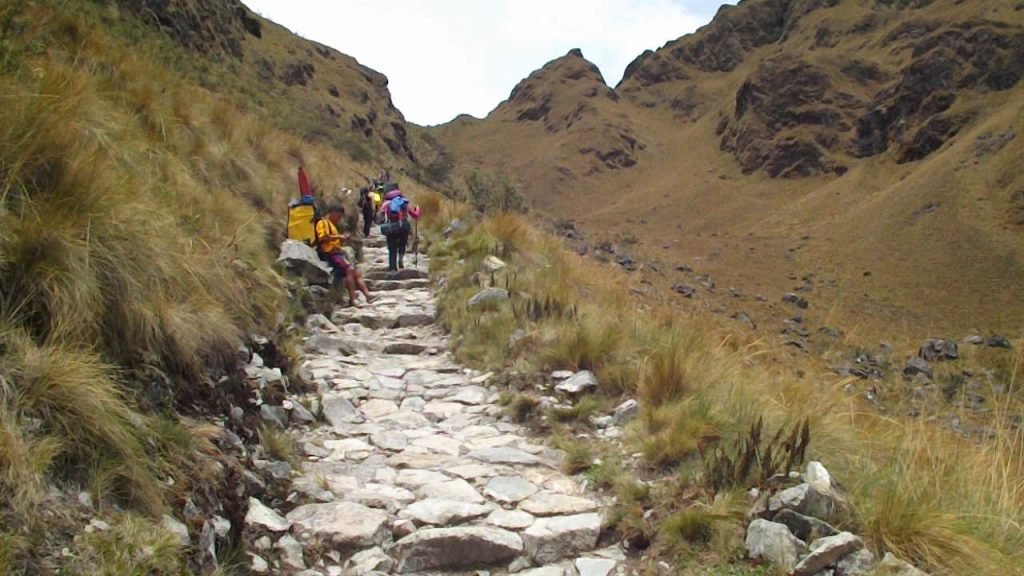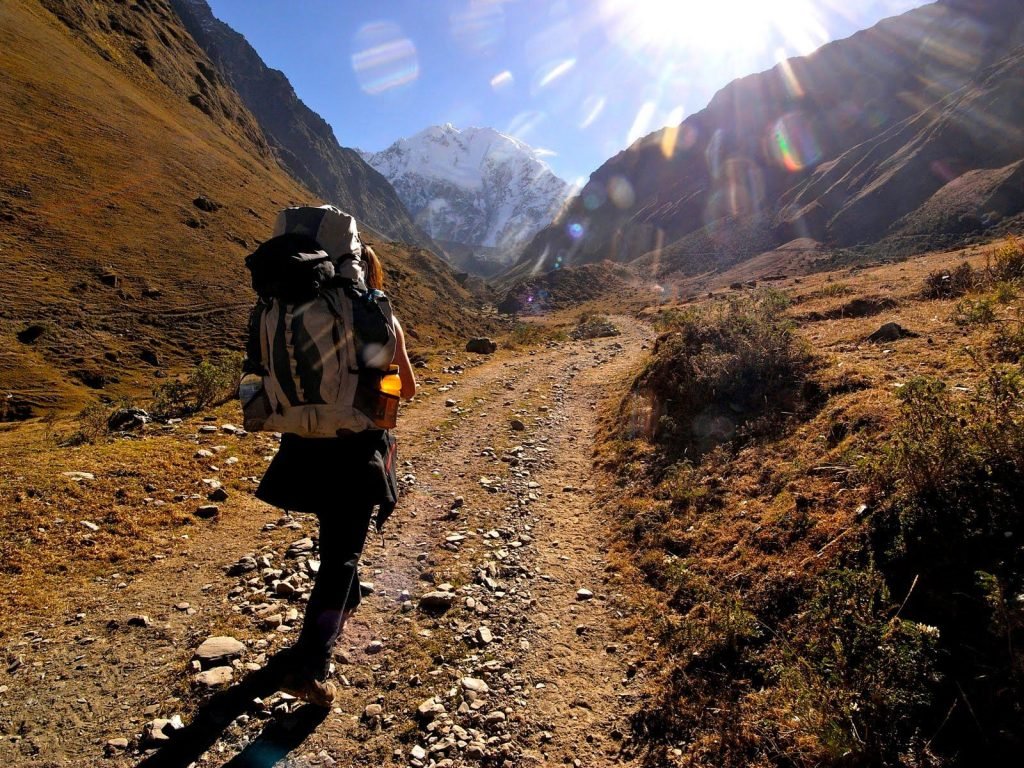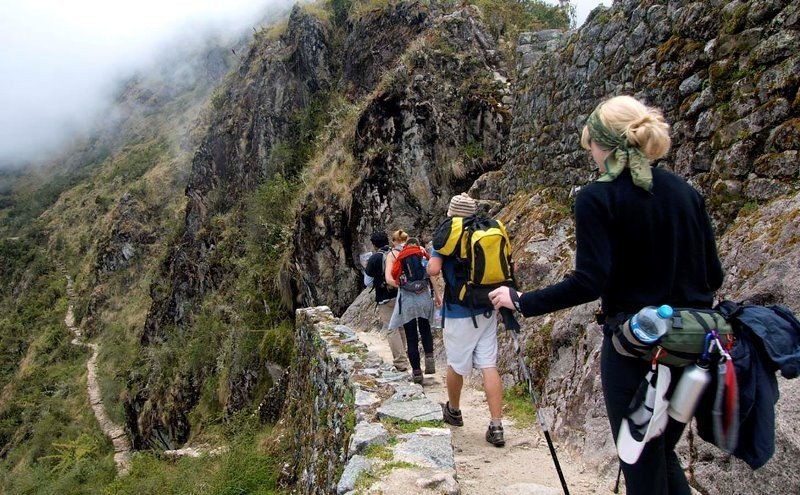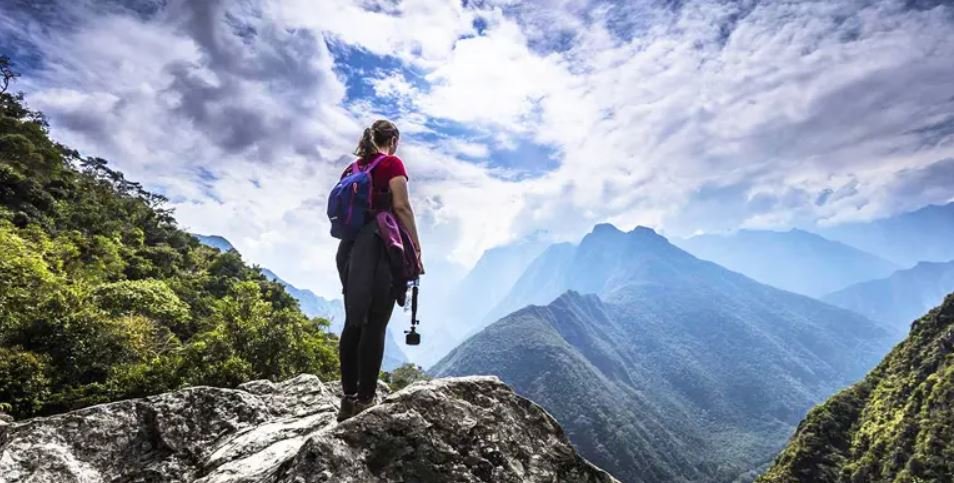Do you need training for the Inca Trail?
There is definitely a basic level of fitness training necessary to successfully complete the Inca Trail. The classic route consists of four days of hiking and is over 26 miles (42km) long. The average day hike ranges around 7-10 miles (11-16km). Keep in mind that this is not flat terrain or easy walking. Those hours are spent on uneven terrain and narrow trails, up and down hills.

The hardest part of the Inca Trail is the Dead Woman’s Pass. Although no one has died here, the name is due to the figure formed by the mountains below from the perspective that you will have at this point, you will ascend to heights of almost 4000 meters composed of beautiful landscapes of puna and snowy mountains. Believe me when I tell you that walking is much more difficult at these heights, you can get out of breath very easily but the reward of the landscapes that you will see from this point are incomparable.
More importantly, there are stairs. Lots of stairs. Improving your endurance is the most important aspect of training for the Inca Trail. In addition to physical endurance, that includes improving and strengthening your mental endurance.
Everyone has a different level of fitness. Some of us could probably get out of bed and take the path to complete it without inconvenience. Others, however, will need a few months to improve their fitness and confidence.
How to prepare for the Inca Trail
There are some good ways to help you better prepare for Inca Trail trekking.

Work on a fitness plan If you struggle to climb two flights of stairs, you will need to start training much earlier. In this case, I recommend that you start training for the Inca Trail with 4-6 months in advance, so that by the time your trip arrives, your body will be much more accustomed to heavy physical exertion.
If you already practice hiking frequently and exercise several times a week, it is not necessary to change your routine. A month before the excursion, you should increase to the distances or the duration of your usual training and it is advisable that next to your trip you should be well acclimatized to the consequences of the altitude of the area, to avoid altitude sickness or Soroche for this you can spend one or two days in the city of Cusco, prior to your journey through the Inca Trail.
Even if you are in very good physical shape, you should not overexert yourself on the Inca Trail. Overexerting yourself on the high passes can cause altitude sickness, which will endanger your health.
Familiarize yourself with your hiking equipment.
The Inca Trail is not the place to try your new hiking boots for the first time. Your new boots may look stylish, but you will need to wear them slowly and get used to them to avoid nasty blisters that will impair your experience during your hike.

Short hikes will slowly soften and adapt the boots to your feet so that they are ready for the more strenuous Inca Trail. Similarly, test other additional equipment you will be traveling with and hiking clothing before embarking on the Inca Trail. Make sure the clothing you plan to wear is comfortable and accurate for the weather you will experience along the trail. If you plan to use walking poles, practice with them before setting out on the trail.
Training for the Inca Trail – Basic Training
Here are some basic exercises to help you prepare your body and mind for the strenuous hike along the Inca Trail.
Cardiovascular exercise
Aerobic exercise or cardiovascular training should be your main focus in preparation for the Inca Trail. These types of exercises will help your body build mitochondria. Mitochondrial cells maximize oxygen use and improve endurance. This will be vital when you are hiking at high altitudes along the Inca Trail.
Cardio workouts mean doing easy to moderate training in longer sessions. Even with an increased heart rate, you should be able to sustain the activity for an extended time.
Here are some examples of cardiovascular exercises:
- Running
- Walking briskly
- Cycling
- Swimming
If you’re struggling to breathe, you’re probably pushing yourself too hard. Slow down or reduce the time or distance of your workout until you are in better shape and can cope with these routines without difficulty.
If you hardly do any cardiovascular exercise, start by walking briskly for half an hour a day. Over time, you can walk 3-4 times a week or swim in the pool.
Hiking
Plotting hiking routes on paved roads in the suburbs is very different from hiking through mountainous landscapes. In the months leading up to the trail, venture out on day hikes. Look for trails close to home and get out every weekend for a multi-hour hike where your body gets used to the exertion and you can maintain a good pace without tiring.
Choose long and moderate routes or short and difficult routes with a lot of climbing. This will help you a lot to face the endless stairs of the Inca Trail. Pack a daypack with water, snacks, extra clothes or even a small weight. This way, you will get used to carrying a daypack for an extended period of time.
Legs and core muscle strength
Core strength refers to the muscles of the spine and pelvis. The core is the powerhouse of the body and affects almost every movement we make on a daily basis.
Your legs are going to do most of the work on the walk. That’s why leg strength and flexibility are critical. To improve your fitness while hiking, you’ll need to work different leg muscles during your workout. Specifically, the hamstrings, glutes, quads and calves.
Having good trunk and leg strength increases endurance and improves balance. This reduces the chances of injury during hiking.
Here are some exercises that work the trunk and help strengthen the legs:
- Squats
- Lunges
- Crunches
- Leg lifts
- Yoga
- Pilates
- Kettlebell swings
Up the stairs
Stairs are your best ally in your Inca Trail training. Skip the elevator and do some extra cardio.
Whether it’s up to your apartment, the mall, or a nearby multi-story building. You’ll be thankful you’ve climbed a few floors each day when you’re halfway up the Dead Woman’s Pass, the most difficult area to negotiate along the Inca Trail.
Upper body strength
Fortunately, porters will carry camping equipment and other heavy items between camps. Even so, you will have to carry a backpack for 5-8 hours a day. You will need to develop upper body strength to carry a few kilos on the Inca Trail so that it does not impair your walking pace.
Incorporate a couple of sets of arm and shoulder exercises into your weekly workout plan. This can include:
- Push-ups
- Shoulder presses
- Light weight lifting (multiple repetitions and small weights)
Stretching
Stretching is important to improve flexibility and range of motion. Adding stretching to your daily routine will also reduce post-workout muscle soreness. Simply put, the more you stretch, the less stiff and sore you will be after hiking and you won’t suffer the effects of overexertion.
When stretching before or after a hike, focus on specific muscle groups. Some good stretching exercises are:
- Hamstring Yoga – Downward Facing Dog and Pyramid are easy poses to start with.
- Hip flexor stretches
- Iliotibial band stretches
- Stretches for quadriceps and gluteus muscles
- Using a foam roller
Mental preparation for the Inca Trail
Your mental endurance is equally or more important than your physical ability to walk the Inca Trail. As the old saying goes, it is ‘Mind over Matter’. Before you set out on the trail, mentalize your goal and prepare your mind for the journey ahead.
Most of the anxiety comes from not knowing what to expect or not being ready for the challenge that the Inca Trail will offer. Reading detailed guides about the Inca Trail will take away some of the uncertainty you may feel. Also, check out the reviews for first-hand accounts from people who have done the trail.
There may be times on the Inca Trail when you feel you can’t take another step. That’s when a strong mentality will help you get through it and keep going.
Physical training will help you push your limits and appreciate what your body is capable of. This will give you confidence to complete even the most difficult parts of the hike.
Inca Trail Training Plan – Month by Month
Each person has a different level of fitness and capabilities. As such, there is no “one size fits all” plan when it comes to training for the Inca Trail.
The tables below are only indicative to give you an idea of what each week’s training should look like. We recommend that you monitor your progress and make the necessary adjustments to suit your needs and time arrangements, the most important thing is always to start preparing no matter if it is one walk a day, all of which you will be grateful for when you are on the road.
First, take a look at the general categories below. From here, you can decide which category you fit into and then plan the level of training you will need.
- Beginner: Currently has no exercise regimen and minimal physical activity. He gets out of breath after walking a few blocks. The Inca Trail will be his first major hike.
- Moderate: You choose to walk whenever possible and try to exercise once or twice a week. Occasionally, you hike with friends or family on the weekend.
- Advanced: You commit to 3 to 5 exercise sessions per week. This can be running, going to the gym or joining a sports team. You hike often and have already completed at least one multi-day hike.
3 Months For The Inca Trail – Weekly Training Plan
| Week 1 | Cardio | Fortress | Stretch | Hiking |
| Beginner | 3-4x 30min walking | 2 sessions of 15 minutes | Daily | 30-minute stairs or 2-hour easy hike |
| Moderate | 3x 1-hour sessions | 2 sessions of 20 minutes | Daily + 1 x 20 min Yoga | Moderate walk of 3 to 4 hours |
| Advanced | Maintain the existing regime | Maintain the existing regime | Maintain the existing regime | 1 challenging full-day hike |
| Week 2 | Cardio | Fortress | Stretch | Hiking |
| Beginner | 3-4x 45min walking | 2x 15min sessions | Daily | 35-minute stairs or 2-hour easy hike |
| Moderate | 3x 1-hour sessions | 2x 25min sessions | Daily + 1x 20 min Yoga | Moderate walk of 3 to 4 hours |
| Advanced | Maintain the existing regime | Maintain the existing regime | Maintain the existing regime | 1 challenging full-day hike |
| Week 3 | Cardio | Fortress | Stretch | Hiking |
| Beginner | 4x 1h walk, some jogging | 2x 15min sessions | Daily | 40-minute stairs or easy/moderate 2-hour hike |
| Moderate | 4x 1-hour sessions | 2 sessions of 30 minutes | Daily + 1x 20min Yoga | 1x 3-4 h, moderate |
| Advanced | Maintain the existing regime | Maintain the existing regime | Maintain the existing regime | 1 challenging full-day hike |
| Week 4 | Cardio | Fortress | Stretch | Hiking |
| Beginner | 4 x 1 hour walk, some jogging | 2x 15min sessions | Daily | 45min stairs/ moderate walk 2hr 30min |
| Moderate | 4x 1-hour sessions | 2 sessions of 30 minutes | Daily + 1 X 20min Yoga | 1x 3-4 hour hike with some steep climbs |
| Advanced | Maintain the existing regime | Maintain the existing regime | Maintain the existing regime | 1 challenging full-day hike |
2 Months for the Inca Trail – Weekly Training Plan
| Week 1 | Cardio | Fortress | Stretch | Hiking |
| Beginner | 4x 1-hour sessions | 2x 20min sessions | Daily + 1x 15min Yoga | 1x 2-3 hour hike, moderate terrain |
| Moderate | 4-5 sessions of 1 hour | 2 sessions of 30 minutes | Daily + 1x 20-30min Yoga | 1x 4hr +, moderate – difficult |
| Advanced | Maintain the existing regime | Maintain the existing regime | Maintain the existing regime | 1 challenging full-day hike |
| Week 2 | Cardio | Fortress | Stretch | Hiking |
| Beginner | 4x 1-hour sessions | 2 sessions of 20 minutes | Daily + 1x 15min Yoga | 1x 2-3 hours of walking, moderate terrain |
| Moderate | 4-5 sessions of 1 hour | 2 sessions of 30 minutes | Daily + 1x 20-30min Yoga | 1x 4hr+, moderate – challenging |
| Advanced | Maintain the existing regime | Maintain the existing regime | Maintain the existing regime | 1 challenging full-day hike |
| Week 3 | Cardio | Fortress | Stretch | Hiking |
| Beginner | 4x 1-hour sessions | 2x 25min sessions | Daily + 1x 20min Yoga | 1x 3-4 hour hike, moderate with uphills |
| Moderate | 4-5 sessions of 1 hour | 2 sessions of 30 minutes | Daily + 1x 20-30min Yoga | 1x 4hr+, moderate – challenging |
| Advanced | Maintain the existing regime | Maintain the existing regime | Maintain the existing regime | 1 challenging full-day hike |
| Week 4 | Cardio | Fortress | Stretch | Hiking |
| Beginner | 4x 1-hour sessions | 2x 25min sessions | Daily + 1 X 20min Yoga | 1x 3-4 hour hike, moderate with uphills |
| Moderate | 4-5 sessions of 1 hour | 2 sessions of 30 minutes | Daily + 1x 20-30min Yoga | 1x 4hr +, moderate – difficult |
| Advanced | Maintain the existing regime | Maintain the existing regime | Maintain the existing regime | 1 challenging full-day hike |
1 month for the Inca Trail – Weekly Training Plan
| Week 1 | Cardio | Fortress | Stretch | Hiking |
| Beginner | 4 -5 sessions of 1 hour | 2 sessions of 30 minutes | Daily + 1x 20min Yoga | 1x 4-6 hours hiking, moderate – challenging |
| Week 1 | Cardio | Fortress | Stretch | Hiking |
| Beginner | 4 -5 sessions of 1 hour | 2 sessions of 30 minutes | Daily + 1x 20min Yoga | 1x 4-6 hours hiking, moderate – challenging |
| Moderate | 4-5 sessions of 1 hour | 2 sessions of 30 minutes | Daily + 1x 30min Yoga | 1x 4-6 hours hiking, moderate – challenging |
| Advanced | Increase training duration or distance, maintain the same intensity. | Increase training duration or distance, maintain the same intensity. | Increase training duration or distance, maintain the same intensity. | 1 challenging full-day hike |
| Week 2 | Cardio | Fortress | Stretch | Hiking |
| Beginner | 4-5 sessions of 1 hour | 2 sessions of 30 minutes | Daily + 1x 20min Yoga | 1x 4-6 hours of walking, moderate – challenging |
| Moderate | 4-5 sessions of 1 hour | 2 sessions of 30 minutes | Daily + 1x 30min Yoga | 1x 4-6 hour hike, moderate – challenging |
| Advanced | Increase training duration or distance, maintain the same intensity. | Increase training duration or distance, maintain the same intensity. | Increase training duration or distance, maintain the same intensity. | 1 challenging full-day hike |
| Week 3 | Cardio | Fortress | Stretch | Hiking |
| Beginner | 4-5 sessions of 1 hour | 2 sessions of 30 minutes | Daily + 1x 20min Yoga | 1x 4-6 hours hiking, moderate – challenging |
| Moderate | 4-5 sessions of 1 hour | 2 sessions of 30 minutes | Daily + 1x 30min Yoga | 1x 4-6 hours hiking, moderate – challenging |
| Advanced | Increase training duration or distance, maintain the same intensity. | Increase training duration or distance, maintain the same intensity. | Increase training duration or distance, maintain the same intensity. | 1 challenging full-day hike |
| Week 4 | Cardio | Fortress | Stretch | Hiking |
| Beginner | 3x 1-hour sessions | 2x 30min sessions | Daily + 1x 20min Yoga | rest |
| Moderate | 3x 1-hour sessions | 2 sessions of 30 minutes | Daily + 1x 30min Yoga | rest |
| Advanced | Increase the duration or distance of the workout, maintain the same intensity. | Increase the duration or distance of the workout, maintain the same intensity. | Increase the duration or distance of the workout, maintain the same intensity. | Increase the duration or distance of the workout, maintain the same intensity. |





